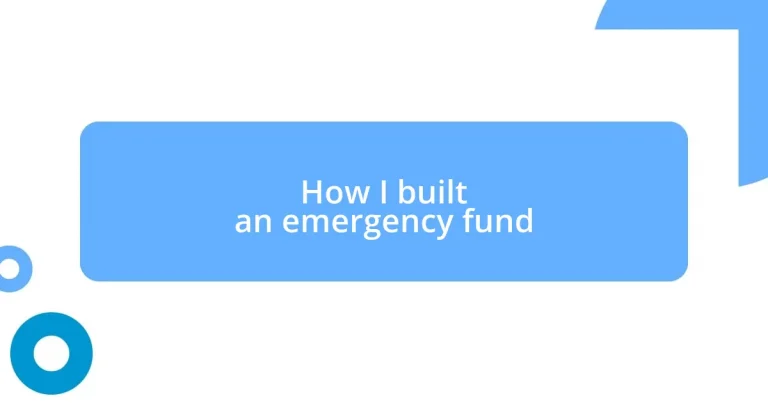Key takeaways:
- An emergency fund is essential for financial and emotional security during unexpected events.
- Setting realistic savings goals and breaking them into manageable monthly steps makes saving achievable and motivating.
- Choosing the right savings account, such as high-yield accounts, maximizes savings while avoiding hidden fees.
- Regularly tracking progress and adjusting savings strategies helps maintain momentum and adapt to changing financial circumstances.
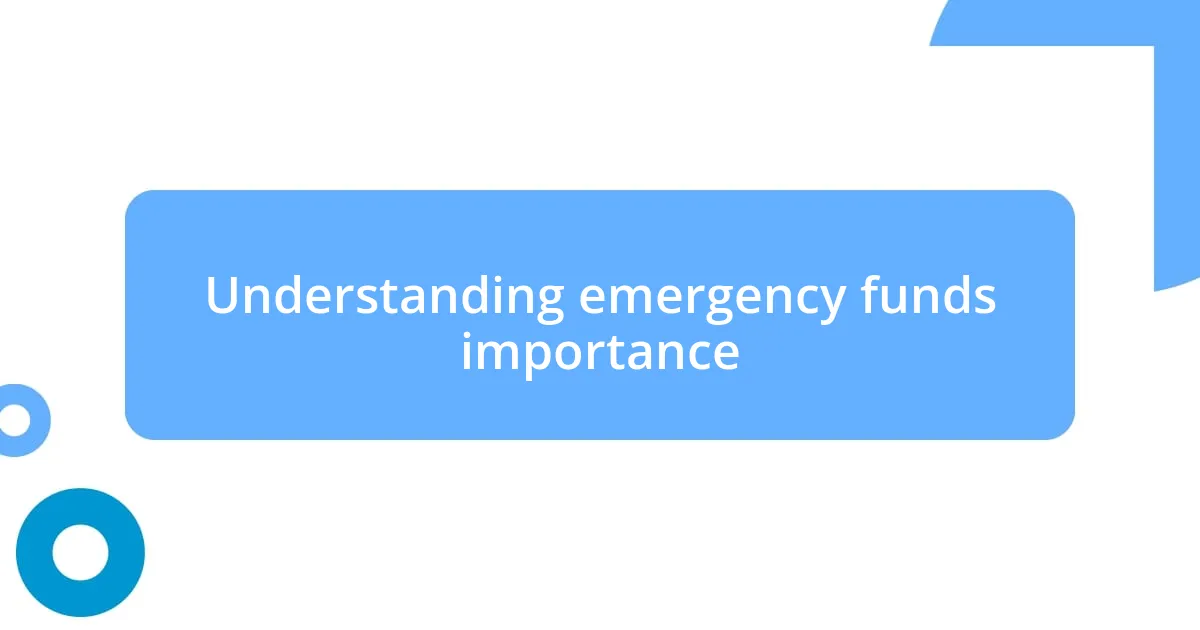
Understanding emergency funds importance
When I first started my financial journey, I didn’t think much about an emergency fund. Yet, when my car broke down unexpectedly, the stress of the situation was compounded by not having any savings set aside. That experience opened my eyes to the true importance of having a financial safety net—it’s a crucial buffer that protects our peace of mind during life’s curveballs.
You might wonder why some people say that an emergency fund is worth its weight in gold. Imagine facing a medical expense or losing your job; those situations can feel overwhelming. Having even a modest emergency fund eases that financial burden, allowing you to focus on recovery and finding your next opportunity without the added worry of mounting bills.
Reflecting on my own experiences, I realize that life is often unpredictable. Is there anything more unsettling than facing a financial crisis without a plan? An emergency fund doesn’t just serve a practical purpose; it provides emotional security, empowering you to navigate surprises with confidence.

Setting realistic savings goals
Setting realistic savings goals is a key step in building an emergency fund that actually works for you. I remember sitting down one day, staring at my bank account, and feeling overwhelmed by the thought of saving thousands. Instead of aiming for a lofty number that felt unattainable, I broke it down into smaller, actionable steps. By setting a monthly goal, I could actually track my progress and celebrate small wins along the way.
Here are some ideas to help you set realistic savings goals:
- Determine your target: Start by aiming for three to six months’ worth of expenses, but adjust this based on your personal circumstances.
- Create a timeline: Decide how quickly you want to reach your goal, whether it’s in a year or two. This gives you a timeframe to work towards.
- Break it down: Divide your total target amount by the number of months until your deadline to find out how much you need to save each month.
- Stay flexible: Life changes, so revisit your goals regularly to ensure they still feel achievable and relevant.
When I began implementing these strategies, it felt less like a burden and more like a personal challenge I was excited to tackle. There’s something incredibly rewarding about seeing your savings grow inch by inch. I began to appreciate that every little deposit brought me one step closer to my financial peace of mind.
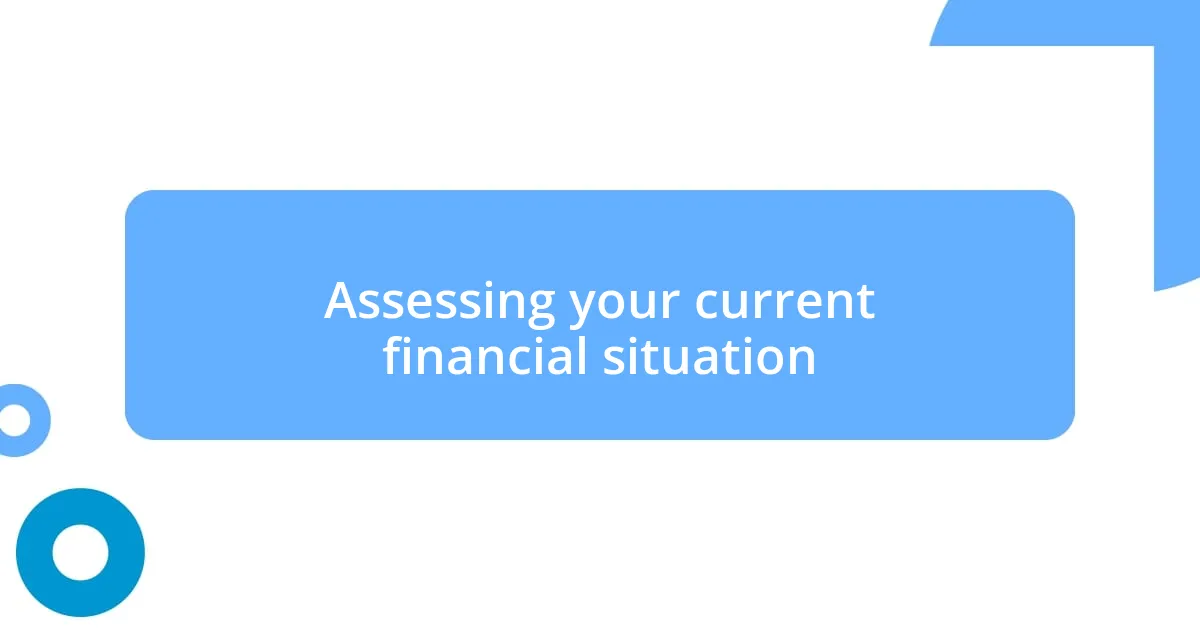
Assessing your current financial situation
Assessing your financial situation is the first essential step in building your emergency fund. Taking time to review your income, expenses, and existing savings can feel daunting, but it’s incredibly illuminating. For me, the moment I did this, I was surprised to find areas where I could cut back—little luxuries that added up to significant amounts.
Next, I set aside a few hours to create a detailed list of all my monthly expenses. I categorized them into essential expenses like rent and groceries, and non-essential ones such as dining out or subscriptions. It was an eye-opening experience. I still recall sitting at my dining table with a cup of coffee, realizing how much I spent on takeout in a month—money that could easily go towards my emergency fund.
To give you a clearer picture of what this process involves, I’ve put together a simple comparison of my finances before and after my assessment. This really helped me visualize my financial landscape and provided a foundation for my savings plan.
| Category | Before Assessment |
|---|---|
| Essential Expenses | $2,500 |
| Non-Essential Expenses | $700 |
| Total Expenses | $3,200 |
| Savings | $300 |
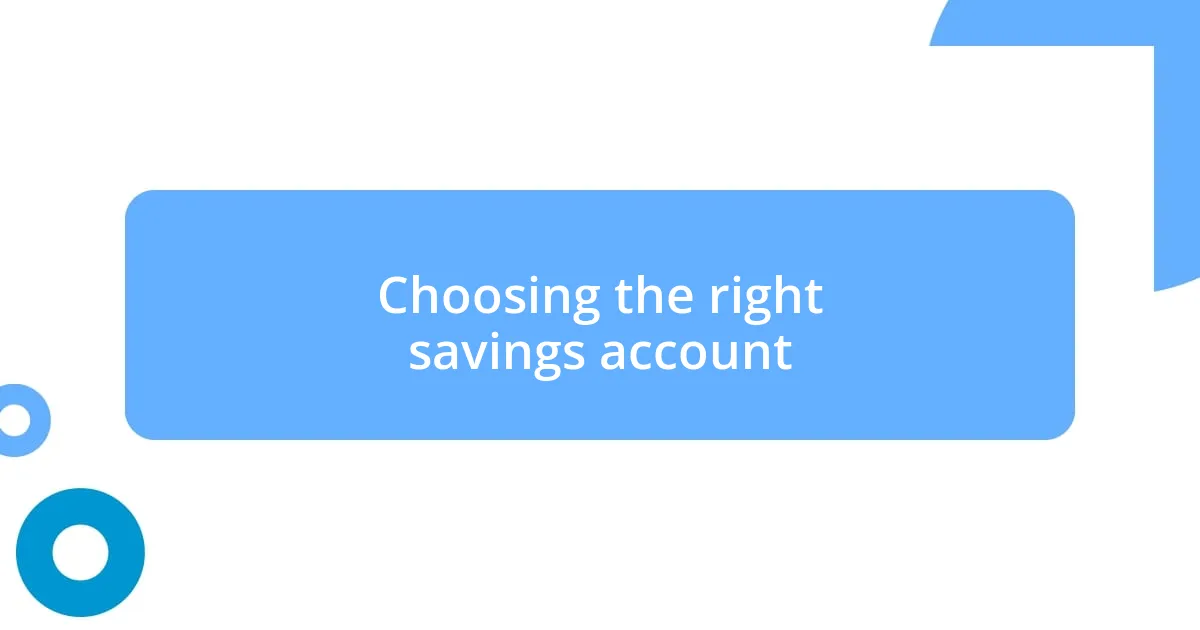
Choosing the right savings account
Choosing the right savings account is crucial in building a solid emergency fund. When I was on this journey, I learned that not all savings accounts are created equal. I wanted something that offered high interest and easy access, so I spent time researching online banks and credit unions. Their rates often outshone traditional banks, and I could manage everything from my phone—super convenient!
One revealing moment for me was stumbling upon high-yield savings accounts. These accounts often provide better interest rates than conventional ones. I remember feeling a mix of excitement and curiosity as I calculated how much more money I could earn over time. Aren’t we all looking for ways to make our money work harder for us? I certainly was, and finding an account that maximized my savings felt like unearthing a hidden gem.
It’s also essential to check for hidden fees and restrictions. When I finally understood the fine print, I realized how detrimental even a small monthly fee could be over the long haul. I had my eye on an account that offered a fantastic rate, but its withdrawal limits made me think twice. Wouldn’t it be a shame to lock away my hard-earned money just when I needed it? By being thorough in my search, I felt empowered to choose an account that aligned with my goals and comfort level.
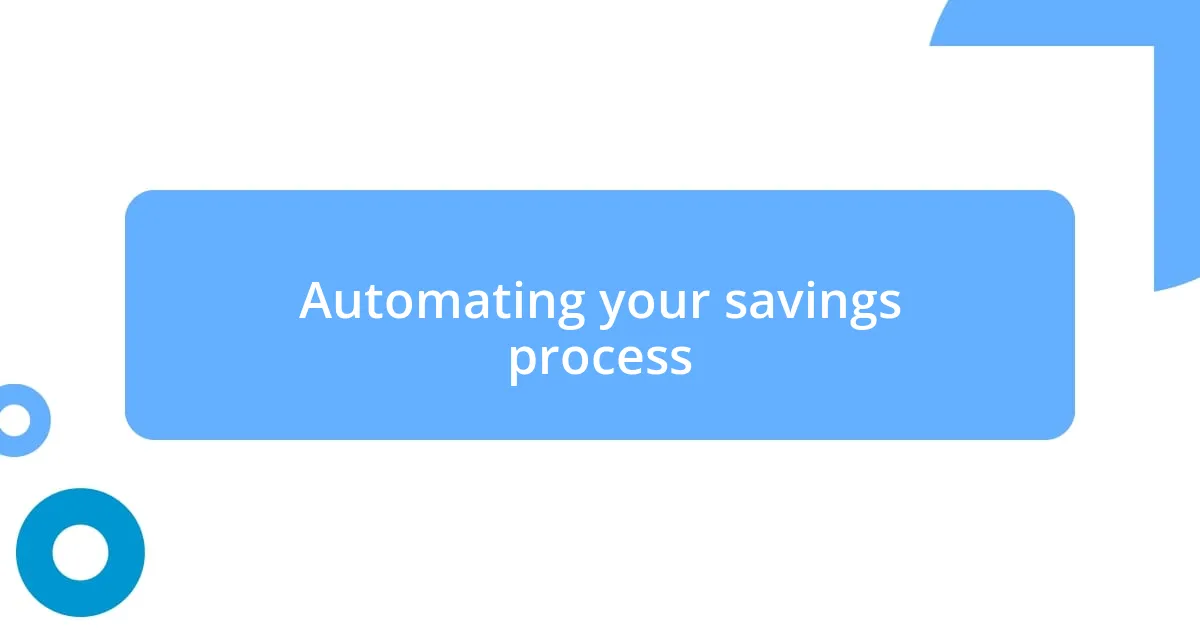
Automating your savings process
Automating your savings is like setting your financial future on autopilot. Once I embraced this approach, I found it to be a game-changer. Each month, I scheduled automatic transfers from my checking account to my newly opened high-yield savings account. This not only simplified my saving process but also made it easier to watch my emergency fund grow without lifting a finger.
I vividly remember the first time I noticed the impact of automation. I had set my transfer to occur right after payday, and I felt a rush of satisfaction as I watched my savings balance increase effortlessly. It felt almost magical to let technology do the heavy lifting for me. Have you ever felt that surge of relief when you don’t have to remember to save? I certainly did, knowing I was building my financial cushion without the stress of having to think about it.
However, automation isn’t a one-size-fits-all solution. You need to review and adjust your transfer amounts periodically. Initially, I started small, but as I grew more comfortable with my budget, I increased my contributions. There’s something empowering about taking control in this way—doesn’t it feel great to know that every bit you save builds toward your peace of mind? Trust me, the sooner you make those transfers automatic, the closer you’ll be to a secure financial future.
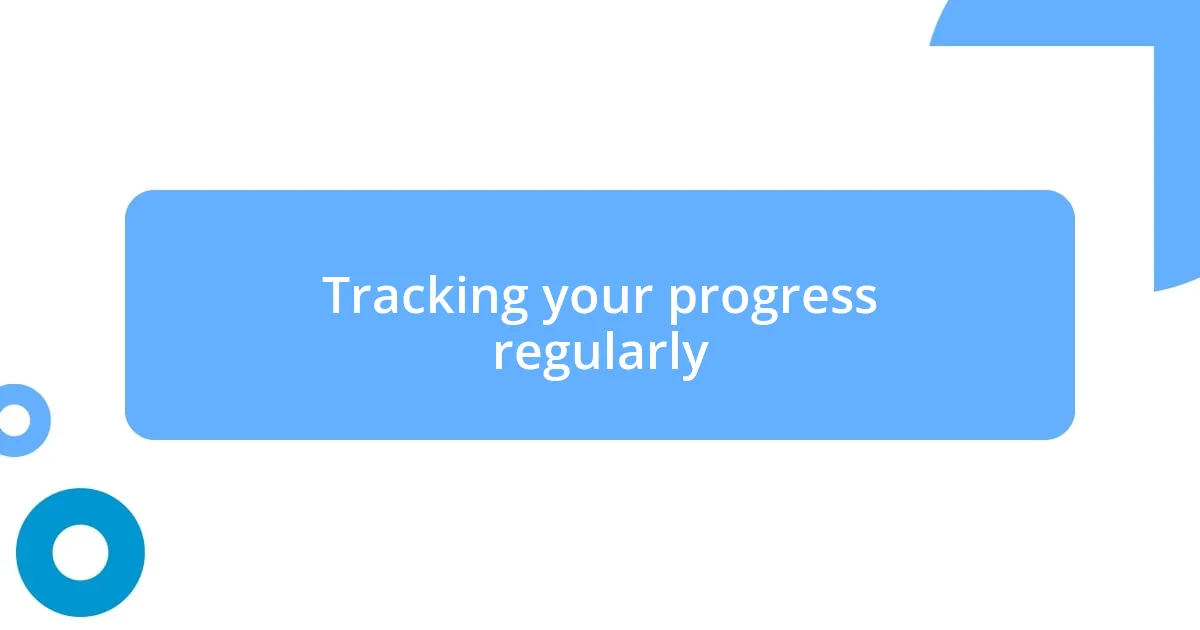
Tracking your progress regularly
Tracking your progress regularly is essential in ensuring you stay on course with your emergency fund. I remember setting a specific time each month to review my savings—it felt like a mini celebration. Every time I logged in and saw that number grow, I couldn’t help but smile. It’s such a motivator to see tangible results of your efforts, isn’t it?
One thing I found particularly helpful was using a simple spreadsheet to chart my progress. Each month, I’d jot down how much I saved and note any growth in interest. Watching that upward trend brought a sense of pride and accomplishment. You might be wondering, how do I even start visualizing my progress? Trust me, even a basic graph can make a significant difference in keeping you motivated.
As I continued to track my fund, I also became more aware of my spending habits. This awareness allowed me to identify areas where I could cut back. For instance, I found that making my morning coffee at home rather than buying it every day contributed significantly to my savings. Have you noticed small expenses adding up? That realization hit me hard, but turning it into action felt incredibly rewarding. By tracking my progress, I could celebrate both small wins and big changes—both crucial in reaching my ultimate goal.
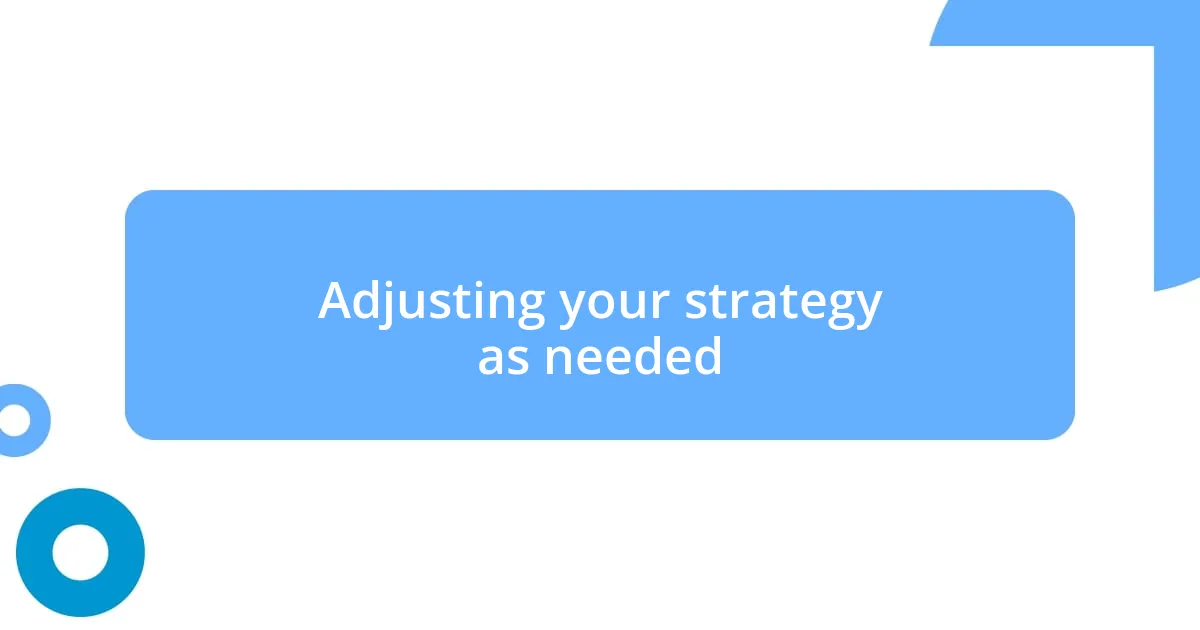
Adjusting your strategy as needed
Adjusting your strategy as needed is crucial to maintaining momentum with your emergency fund. There were times when my initial savings plan just didn’t align with my reality, especially when unexpected expenses popped up. For example, when my car needed unexpected repairs, I had to reassess how much I could realistically save each month without overburdening myself. Have you ever found yourself in a similar situation where life just throws curveballs at you? It’s completely normal.
As I navigated these adjustments, I took a step back and looked at my overall budget. I noticed that some areas had more wiggle room than I initially thought. For instance, I discovered I could limit dining out a couple of times each month, and redirect that money into my emergency fund instead. I distinctly remember that first month I made that change; it was both a challenge and a relief to see funds reallocating where they really mattered. It was a little uncomfortable to tighten my spending, but that discomfort soon transformed into a sense of achievement.
With each adjustment, I learned to be more flexible and responsive to my financial situation. Rather than seeing adjustments as setbacks, I began viewing them as opportunities to innovate my approach. It’s fascinating how shifts in your plan can inspire fresh strategies. Have you found little tweaks that made a big difference in your savings goals? I encourage you to embrace those moments—each adjustment ultimately works toward fortifying your financial security.












